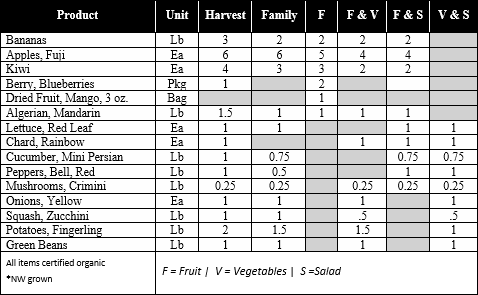It is winter in the NW. For those of us who have been juggling kiddos, school closures, and late starts, it sure is nice to get back to cold, wet, and gray! Although the white, while a challenge to navigate, is beautiful, and our region is dependent upon sufficient snowpack to keep our watersheds happy and functioning properly.
I am really proud of our team and their commitment to pack and safely deliver your boxes of good! The packing team made it every day and our driving team chained up when necessary, and safely delivered 95% of the orders. A few of you live on the less travelled and moderately travelled roads and we couldn’t quite get there, sorry.
On the farm, this weather is just fine. We take it in stride because we mostly focus on the Spring, Summer, and Fall seasons. The only crops actively growing are our cover crops and garlic. The garlic is happy as a clam, not sure what that means, but it is a NW saying. They have poked through the mulch and are about 3-4 inches tall.
This year we are experimenting with a new mulching material. Normally we use organic wheat straw, but this year we added leaves from our walnut trees. Our farm produces walnut leaves in MASS! Normally they end up in the compost and then spread on the fields in the spring, but this year we raked them up and spread them out on top of the garlic. The work to gather and spread the leaves is comparable to the work to purchase, pick up, bring to the farm, and spread the wheat straw. I will be evaluating how they decompose, weed suppression, moisture retention, and soil structure under each mulch. So far, I am pleasantly surprised.
The cover crops we plant are to nourish the soil, hold nutrients in the plants, and protect the soil from compaction. Cover crops are a vital part to farming, but they do have their limitations. We use them on 90% of our soils and leave that remaining 10% “open” or “uncovered.” One of the purposes of a cover crop is to prevent the leaching of nutrients like Nitrogen or Phosphorous out of the root zone, and also out of the aquifers or watersheds. Think the dead zone in the Gulf of Mexico.
Why do I not cover crop the remaining 10%? Through experience, I have learned that cover crops also have a downside. In a wet spring, they can grow, REALLY GROW, and once the weather warms and I can get into the field to till them in, it will take a few weeks for them to break down. The soil bacteria are busy breaking down the cover crop and won’t get to work on growing vegetables for a little while longer. So, we intentionally leave that 10% uncovered for our early plantings of peas and lettuce. It’s just that simple!
Stay warm,
-Tristan

